For some, New Harmony, Indiana, is a thin space. A place where the boundary between heaven and earth closes. Perhaps that’s from its beginnings founded by the utopian Harmony Society in 1814.
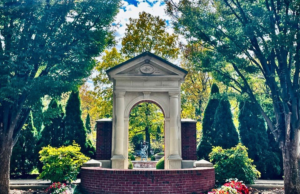
Entrance to Church Park, site of two original Harmonist churches. The fountain was designed by Don Gummer, husband of Meryl Streep. | Photo by Laurie D. Borman
For others, it’s simply a wonderfully preserved town with historic tours, great local food served in classic Victorian buildings, and many events such as the annual Early American Life magazine directory artisan market and Christmas-decorated house tours and tree-lighting ceremonies the first week of December.
“Some people come for the day to browse,” says Lynn Clark, owner of Lowry Hollow, a gift and antique shop on the corner of Main and Steam Mill streets. Clark enjoys showing her shop, a restored Harmonist home with original floors, to her customers. But there are other types of visitors, and Clark welcomes them. “This is a town you feel. They get it,” says Clark. Those visitors seek out the spiritual sanctuaries as well as the secular sites. Clark and her husband, Rodney, moved to nearby Mount Vernon 25 years ago but were frequent visitors to New Harmony and ended up buying a house there seven years ago. Rodney retired from full-time work but is a dedicated town volunteer, New Harmony city council member, and a tour guide at the Atheneum, a sparkling-white modern visitors center designed by prominent U.S. architect Richard Meier and opened in 1979. Funded by Lilly Endowment and Krannert Charitable Trust, it has a gift shop, gallery, and a 1/32 model of the original Harmonist town.
Social experiments and lasting impressions
New Harmony was built beginning in 1814 by the Harmony Society, a Christian sect founded in the late 1700s by German preacher George Rapp. The Harmonists, also known as Rappites, believed in the imminent second coming of Jesus, a celibate life, and rigid work and prayer schedule. They arrived from Harmony, Pennsylvania, in 1814 and quickly went from building log cabins to wooden and brick houses, amassing 180 buildings in just ten years. They had sought out a warmer climate than Pennsylvania had for growing grapes and found it in Indiana. They became successful farmers and established woolen and cotton factories, a brewery, and distillery. In fact, the settlement was so successful, Atheneum tour guide Katie Nurrenbern says, that Rapp decided to take the flock back to Pennsylvania, where the goods were shipped more easily, and those who were getting too comfortable would renew their dedication to the Harmonist life.
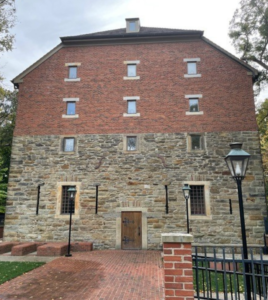
The Rapp-Owen Granary, built in 1818 as a woolen mill, was gutted by fire in 1878 and rebuilt as a granary in 1893. It is now an event venue. | Photo by Laurie D. Borman
In 1825, Rapp sold the town and 20,000 acres for about $150,000 to Richard Owen, a Scottish industrialist. Owen wanted to establish a series of socialist communities that would also be an intellectual and social utopia. With his partner William Maclure, Owen brought visionaries from around the world in scientific, educational, social, and artistic disciplines to New Harmony. They began teaching boys and girls from age two in the Pestalozzian method, to learn by doing.
The school survived, but the socialist community experiment lasted only two years (1825–1826). Problems arose from a lack of skilled labor for the factories and for necessities such as leather and saddle making. And almost immediately there were disagreements about governance, work, and the lack of religious institutions. The bickering never ended, the communities couldn’t stabilize, and all were abandoned within a year after Owen departed in 1827.
The town remained, but not as a socialist experiment. Four of Owen’s sons and daughter Jane Dale stayed, leaving a lasting impression on Indiana. David Dale Owen became the state’s first geologist, and Richard Dale Owen the first president of Purdue University, returning after a year to teach science at Indiana University, Bloomington. IU’s Owen Hall is named after him. He became the second Indiana state geologist. Robert Dale Owen became a U.S. representative for Indiana. Maclure also founded one of the first vocational schools in the nation in New Harmony, the Working Men’s Institute (also known as Workingmen’s Institute). The building survives as the oldest continuously run public library in Indiana and has a free museum with town artifacts on the upper floor, including a Harmonist-era wagon and the skeletal remains of “Old Fly,” a Civil War-era horse.
Exxon Oil and existentialism
The restoration and preservation of New Harmony can be credited to Jane Blaffer Owen, wife of Kenneth Dale Owen, who lived from 1915 to 2010. Blaffer Owen was heir to Humble Oil, the predecessor to Exxon and Mobil Oil. She used her inheritance and clout with other philanthropists to help restore historic buildings and to create new spaces, such as the interdenominational Roofless Church designed by modernist/postmodernist architect Philip Johnson in 1960, that connect nature with the spiritual. These would also be places where residents and visitors could gather, work, teach, and learn about education, science, and artistic endeavors along the lines of the Owen philosophy.
“I wish I had known her,” Lynn Clark mused as she recalled many of Blaffer Owen’s contributions to New Harmony. Nurrenbern says Blaffer Owen was known to walk through town and suggest people tidy their gardens, stopping to help weed if something was neglected.

The Atheneum Visitor Center, designed by Richard Meier, opened in 1979. Meier’s drawings for the Atheneum are part of the architecture collection in New York’s Museum of Modern Art. | Photo by Laurie D. Borman
Today, visitors can learn more about New Harmony’s history via two tours. A tram tour from the Atheneum, sponsored by the University of Southern Indiana, includes a walk inside the David Lenz House and the Rapp-Owen Granary, as well as the Harmonist Cemetery and Roofless Church. Under the main floor of the Rapp-Owen Granary, equipment monitors earth tremors from the New Madras Seismic Zone. Guides have fun jumping up and down on the floor to see their moves on a nearby computer screen. The Indiana State Museum offers a walking tour, starting at Community House #2. It includes access to the Community House museum and stops at Thrall’s Opera House, Fauntleroy House, Harmonist Cemetery, and the Rapp-Owen Granary.
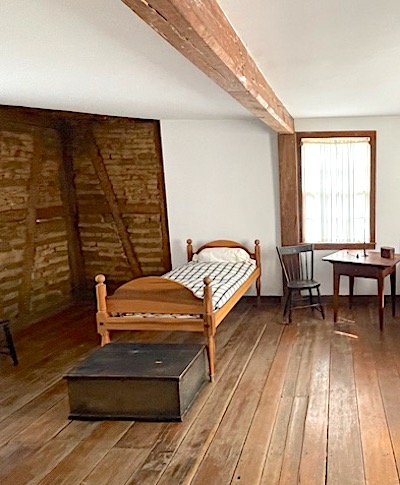
Inside the second floor of the David Lenz House features an exposed wall (left) showing the “Dutch biscuit” construction of wood wrapped with mud and straw. | Photo by Laurie D. Borman
On the Atheneum tour, Nurrenbern highlighted garden plots outside the David Lenz House, including kitchen herbs and medicinal plants of the 1800s, as well as plants used to dye wool. She invited tour participants to sample from the garden “because it’s a community garden, but please just take a sample.” She also pointed out an outdoor brick oven for bread baking and a cowshed where sunflower seeds were drying. Guests were cautioned to take the stairs inside the house only one person at a time due to weight-bearing limit and age of the stairs. An exposed wall showed the “Dutch biscuit” construction: a piece of wood wrapped in mud and straw to form a type of brick.
Outside the tours, visitors can experience New Harmony’s spiritual side by walking the hedge-bordered Harmonist labyrinth at 1239 Main St. or the paved Cathedral labyrinth at North and Archer streets. The Roofless Church features several sculptures and a fountain dedicated in 1999 to grandparents. Walking paths behind the church and the Atheneum wind along the Wabash River, providing time for reflection and the sound of birds. A garden near the church and trails is named after Paul Tillich, a famed existentialist and German theologian who died in 1963 and wanted to make New Harmony a center for his own teachings after professorships at Harvard, University of Chicago, and Union Theological Seminary in New York City. His ashes are in the park.
The spiritual, the historical, the food
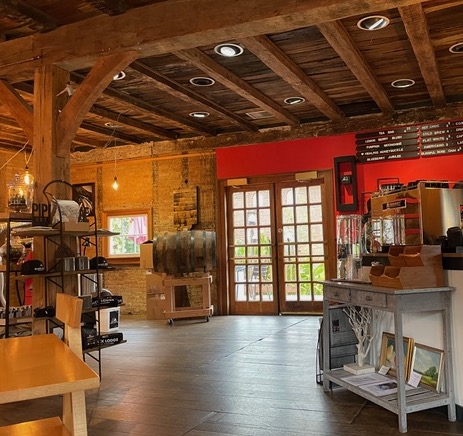
Black Lodge Coffee Roasters resides in a former barrel-making factory; hence, the barrel near the front door. | Photo by Laurie D. Borman
For those more interested in shopping or eating, Main Street and its cross streets offer plenty of options. The Main Cafe, 520 Main St., still has pressed-tin walls and ceilings and features house-made sandwiches for under $10, as well as daily specials with two sides for $10.95. Cash only. Yellow Tavern, 521 Church St., full of old-fashioned advertising signs and a working jukebox, offers sandwiches from $6.25 for a hamburger or grilled cheese to $10.25 for a ribeye sandwich, and amazing daily dessert specials. (A waitress confided that the bread pudding makes a great breakfast, to consider purchasing it for the next day.) Cash only. Black Lodge Coffee Roasters, 610 Church St., roasts its own beans and offers both savory and sweet treats along with fresh coffee, specialty coffee drinks, and teas. The roastery is open from 8 a.m. to 1 p.m. on Monday and 8 a.m. to 3 p.m. Tuesday and Thursday through Sunday. The Red Geranium Restaurant is a fine-dining option for dinner, and offers a special Thanksgiving dinner. It serves breakfast, lunch, and dinner from 8 a.m. to 8 or 9 p.m. Dinner prices range from $23 for a vegetarian stir fry to $55 for a 14-oz. T-bone steak; fresh fish is available, too. (All times listed are Central Time.)
Whether visitors seek the spiritual, the historical, or simply the ambiance of an eclectic town with unique shops and good food, perhaps New Harmony’s greatest asset is the people and their trust in humanity. New Harmony Inn Executive Housekeeper Robin Weyerbacher, who has lived in the town for more than 20 years, says, “It’s a place where your kids grow up and know all the other kids, where you know your neighbors, and where you feel safe.” People smile and wave hello from golf carts, whether they’re locals or visitors. There aren’t discarded cans or trash along the sidewalks or paths. It’s a welcoming place, as it has been for more than 200 years.
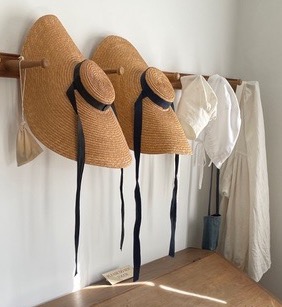
Harmonist-style clothes on pegs inside the David Lenz House. | Photo by Laurie D. Borman
If you go:
New Harmony is about two hours’ drive from Bloomington via interstates 69 and 64. All times listed are Central Time.
For fun, you can rent a golf cart for $18 to $20 an hour and zip around to all the trails, parks, and places. New Harmony Inn and the Atheneum rent carts.
There are a variety of places to stay, from 2-bedroom cabins in nearby Harmonie State Park (two-night minimum) to a 1-bedroom 1840 Garden House with kitchenette at the New Harmony Inn to an 1899 bed and breakfast, the A.C. Thomas House.
Atheneum tram tours last about 90 minutes and are at 1 p.m. Tuesday through Sunday from March 15 to October 31. From November 1 through December 31, tours are on weekends only.
Indiana State Museum walking tours are at 11 a.m. and 3 p.m. year-round, Wednesday through Sunday.
Read more:
Laurie D. Borman’s first travel piece for Limestone Post took us to French Lick and West Baden Springs: “Travel with Laurie: Historic Treasures in French Lick and West Baden Springs.”
Hear more:
LP contributor Michael G. Glab is also host of the WFHB radio show “Big Talk,” and his show of November 16, 2023, featured author Tristra Newyear Yeager, whose new book is set largely in the 19th-century utopian outpost of New Harmony, Indiana.


